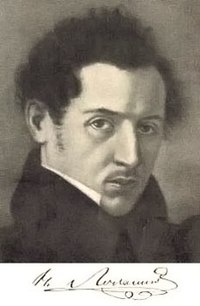Nikolai Lobachevsky

Nikolai Ivanovich Lobachevsky (Никола́й Ива́нович Лобаче́вский) (December 1 1792–February 24 1856 (N.S.); November 20 1792–February 12 1856 (O.S.)) was a Russian mathematician.
Biography
Lobachevsky was born in Nizhny Novgorod, Russia. His parents were Ivan Maksimovich Lobachevsky, a clerk in a landsurveying office, and Praskovia Alexandrovna Lobachevskaya. In 1800, his father died and his mother moved to Kazan. In Kazan, Nikolai Ivanovich Lobachevsky attended Kazan Gymnasium, graduating in 1807 and then Kazan University which was founded just three years earlier, in 1804.
At Kazan University, Lobachevsky was influenced by professor Johann Christian Martin Bartels (1769–1833), a former teacher and friend of German mathematician Carl Friedrich Gauss. Lobachevsky received a Master's degree in physics and mathematics in 1811. In 1814, he became a lecturer at Kazan University, and in 1822 he became a full professor. He served in many administrative positions and was the rector of Kazan University from 1827 to 1846. He retired (or was dismissed) in 1846, after which his health rapidly deteriorated. In addition to teaching mathematics and physics at Kazan University Lobachevsky also was an astronomy teacher there.
In 1832, he married Varvara Alexivna Moisieva. They had seven children.
Mathematical results
Lobachevsky's main achievement is the development (independently from János Bolyai) of non-Euclidean geometry. Before him, mathematicians were trying to deduce Euclid's fifth postulate from other axioms. Euclid's fifth is a rule in Euclidean geometry which states (in Playfair's John Playfair reformulation) that for any given line and point not on the line, there is one parallel line through the point not intersecting the line. Lobachevsky would instead develop a geometry in which the fifth postulate was not true. This idea was first reported on February 23 (Feb. 11, O.S.), 1826 to the session of the department of physics and mathematics, and this research was printed in the UMA (Вестник Казанского университета) in 1829–1830. Lobachevsky wrote a paper about it called A concise outline of the foundations of geometry that was published by the Kazan Messenger but was rejected when the St. Petersburg Academy of Sciences submitted it for publication.
The non-Euclidean geometry that Lobachevsky developed was called hyperbolic geometry. Lobachevsky replaced Euclid's parallel postulate with the postulate that there is more than one parallel line through any given point; a famous consequence is that the sum of angles in a triangle must be less than 180 degrees.
The recognition of his ideas by the mathematical community was quite slow. Some mathematicians and historians have claimed that Lobachevsky stole his concept of non-Euclidean geometry from Gauss, but this is not true because Lobachevsky was not corresponding with Gauss at the time; Lobachevsky deserves full credit for inventing non-Euclidean geometry.[1] These ideas were fully accepted only several decades after Lobachevsky's death. But non-Euclidean geometry turned out to be very important for mathematics and science; the German physicist Albert Einstein used a generalization of it for his theory of general relativity.
Lobachevsky's magnum opus Geometriya was completed in 1823, but was not published in its exact original form until 1909, long after he had passed away. Lobachevsky was also the author of New Foundations of Geometry (1835-1838). He also wrote Geometrical Investigations on the Theory of Parallels (1840) and Pangeometry (1855).
Another of Lobachevsky's achievements was developing a method for the approximation of the roots of algebraic equations. This method is now known as Dandelin-Gräffe method, named after two other mathematicians who discovered it independently. In Russia, it is called the Lobachevsky method. Lobachevsky gave the definition of a function as a correspondence between two sets of real numbers (Dirichlet gave the same definition independently soon after Lobachevsky).
In popular culture
In the 1950s, humorist, satirist, and mathematician Tom Lehrer wrote a song, inspired by a Danny Kaye routine about Stanislavsky, in which he credited Lobachevsky with teaching him the secret of success as a mathematician: plagiarism ("Plagiarize! Let no one else's work evade your eyes! Remember why the Good Lord made your eyes, don't shade your eyes, but plagiarize! Plagiarize! Plaagiarize! Only be sure always to call it, please, 'research.'!") Lehrer chose Lobachevsky mainly because his name was reminiscent of Stanislavsky's, and not because Lobachevsky is particularly known for this misdemeanor.
In Poul Anderson's novella "Operation Changeling" (F&SF, 1969; Operation Chaos, 1971), a group of sorcerers navigate a non-Euclidean universe with the assistance of the ghosts of Lobachevsky and Bolyai. (The novella also makes a reference to Lehrer's song.)
See also
- Non-Euclidian geometry
- Hyperbolic geometry
- Hyperboloid structure
- Gauss-Bolyai-Lobachevsky space
- Upper half-plane
- Lobachevskiy (crater)
- Lobachevsky Medal
External links
- O'Connor, John J.; Robertson, Edmund F., "Nikolai Lobachevsky", MacTutor History of Mathematics Archive, University of St Andrews
- Lobachevsky song by Tom Lehrer, in MP3 format.
- [2] Web site dedicated to Lobachevsky (in Spanish).
